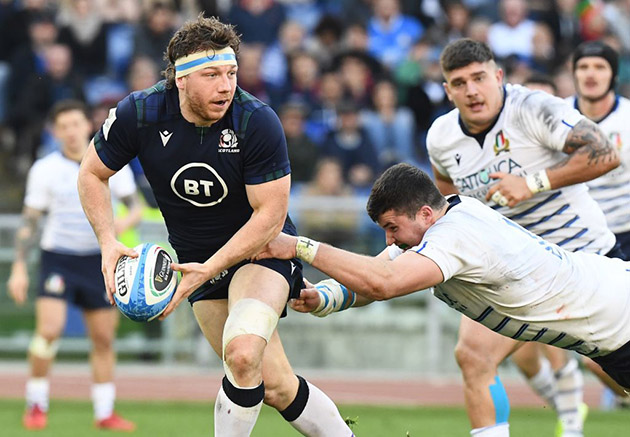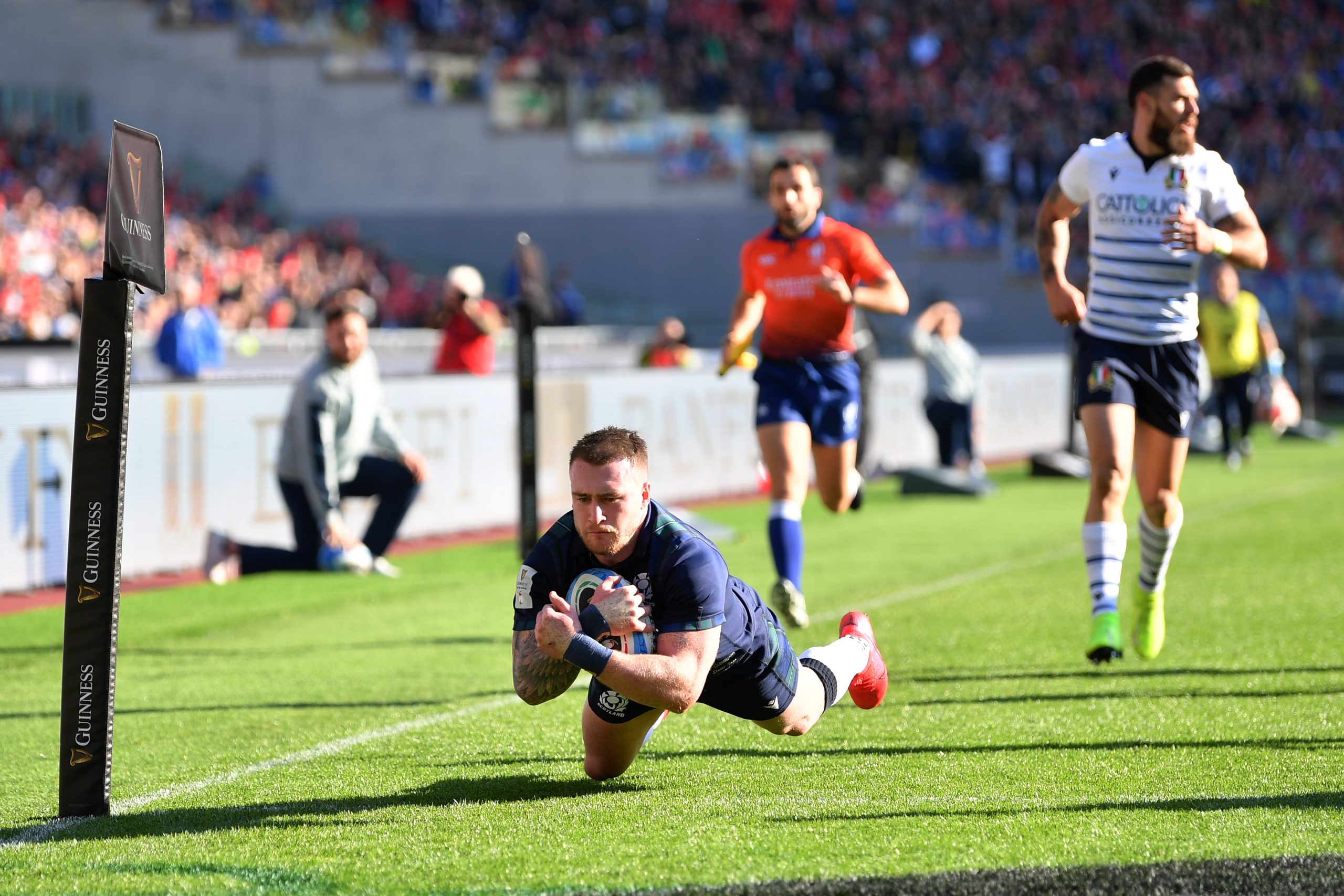From the excellence of Gael Fickou and Hamish Watson to the Italy’s role reversal, Jacob Whitehead reflects on the weekend’s happenings
Hamish Watson enhances his Lions chances
Back-row selection for the 2021 Lions tour to South Africa will be incredibly competitive. Challenging for starting spots on the flank will be Tom Curry, Sam Underhill, Josh Navidi, Justin Tipuric, Aaron Wainwright, hopefully Dan Leavy… the list goes on.
But Hamish Watson must enter the conversation after an incredible Man of the Match performance against Italy in the Six Nations. He has had an outstanding tournament so far – Scotland’s star man in their losses in the first two rounds – and his performances have only improved alongside partner-in-crime Jamie Ritchie.
Yes, Italy’s forwards were poor, but some credit has to go to Watson’s mongoose-like performance. He was the top Scottish tackler with 19 and carried for 62 metres, more than any other forward on the pitch except for Jake Polledri. He also won two turnovers on the ground. And he wears his tartan collar like vintage Eric Cantona.
The last Scottish back-rower to appear in a Lions Test was Rob Wainwright back in 1997; Watson has an excellent chance of being the next 24 years later.
Italy’s traditional strengths and weaknesses have been flipped
Italy had most of their Six Nations success between 2007 and 2013, a period in which they reached their highest-ever world ranking of eighth.
Their success was built on an excellent generation of forwards who often achieved set-piece dominance and generally ensured quick ball. Seven of their starting pack were usually unchanged – Andrea Lo Cicero, Leonardo Ghiraldini, Martin Castrogiovanni, Marco Bortolami, Alessandro Zanni, Mauro Bergamasco and Sergio Parisse would each win a century of caps.
Conversely their back-line often struggled. After the retirements of Diego Dominguez in 2003 and Alessandro Troncon in 2007 they had no consistent half-back partnership, whilst their only world-class back was the protean Mirco Bergamasco (with an honourable mention for Andrea Masi).
Fast-forward to 2020 and their game against Scotland, and the landscape couldn’t look more different. The Italian back-line looks sharp. Tommaso Allan is playing the best rugby of his life, whilst half-back partner Callum Braley looks experienced beyond his years. I wrote two weeks ago about how Carlo Canna’s introduction as a secondary distributor for Italy has sparked the Azzuri back-line – and this was on full display in Rome on Saturday.
Italy made more metres than Scotland, despite two Scottish breakaway tries, and wings Matteo Minozzi and Mattia Bellini sparkled, particularly in the first half. However, Italy did not score a point, as they fell to a 17-0 defeat.
Why? Crucially, they turned the ball over 22 times, time after time being unable to recycle good phase play from the back-line. Italy were also monstered in the scrum, with prop Giosue Zilocchi, who had an impressive first two rounds, hauled off after 30 minutes.
The game showed how much Italy’s traditional strengths and weaknesses have changed over the course of the decade. Only Zanni remains from the golden generation of forwards, and whilst Braam Steyn is excellent and Jake Polledri could be talismanic, the forwards lack the depth of Italian teams of yesteryear.
This back-line can be dynamic – they just need the ball and the base to perform.
Second divisions are crucial to national teams – just look at France
This France team look to be the real deal, winning away in Wales for the first time in ten years, against the most experienced XV to ever take the field in the Six Nations. Two tough games await them – away at Murrayfield and at home to Ireland, but they have a brilliant chance to once again begin the decade with a Grand Slam.
However, in a period where Championship clubs have had their funding cut by the RFU, France have shown the RFU the flaws in their argument.
Just look at their key men this tournament. Gregory Alldritt, who was Man of the Match in their first two games, came through the youth system of FC Auch, who played in the ProD2 and Fédérale 1. Note the past tense – a lack of investment in the lower divisions forced Auch to wind up their professional set-up in 2017. It’s a stark lesson to the RFU on the quality of players they could miss out on.

French star: Gregory Alldritt gets a pass away against Wales (Getty Images)
Cameron Woki, another highly-rated back-rower, came through at Pro D2 side RC Massy, whilst Demba Bamba, who won a controversial but crucial scrum penalty in the win against Wales, was playing in the second division for Brive when he made his professional debut last year.
Full-back Anthony Bouthier, unlucky not to win MOTM in Cardiff, is perhaps the starkest example – this is his first season playing in the Top 14, having played for Vannes, a ProD2 club, for over half a decade.
Teams such as Nottingham have warned that they may not be able to survive budget cuts, whilst the likes of Jersey Reds and Ealing Trailfinders are clubs on the rise. France have shown the importance of these second-tier clubs.
Gael Fickou has been a quiet standout
A while ago and Gael Fickou was an enigma. Capable of brilliant moments – like the winning try against England at the age of only 19 – but also often kept quiet, struggling with the lack of a consistent centre partner since Wesley Fofana’s injury troubles.
However, with Romain Ntamack and Virimi Vakatawa now established in this France team, Fickou’s form has been excellent, despite often being overshadowed by the contributions of Ntamack, Antoine Dupont and Bernard Le Roux.
The last three games have really shown Fickou’s flexibility, as he has been asked to play three different roles by Fabien Galthié. In the win over England he led France’s defensive press from 13, a key role in Shaun Edwards’s system, which Jonathan Davies has done so well for the past decade for Wales.
MORE FROM THE SIX NATIONS
Stuart Hogg scores scorching try in Rome sunshine
Stuart Hogg scores scorching try in Rome sunshine…
Johnny Sexton fumble leads to George Ford try
Irish errors play part in England's 24-12 win…
France keep Grand Slam bid on track with win in Cardiff
The French beat Wales 27-23 in dramatic game…
Against Italy, with Vakatawa injured, he was asked to step into the 12 shirt and performed a brilliant job as a second receiver, showing a deft kicking game hitherto unseen at international level.
Then with Damian Penaud and Vincent Rattez injured, he moved out to the wing, putting in a performance which merited a try (he had one disallowed), keeping George North and then the dangerous Johnny McNicholl quiet.
French players have starred in this tournament. But its time to show some love to a man who has been asked to play a radically different game in each round – and delivered.
Rumours of England’s demise have been greatly exaggerated
England looked back to their best in their 24-12 win over Ireland, winning games with the emphatic physicality last seen in their semi-final victory over New Zealand.
To their credit Ireland stood up manfully, but the ball rarely progressed into their back-line, with remorseless midfield pressure put upon Johnny Sexton by Sam Underhill, Maro Itoje and Courtney Lawes.
England needed a performance like this after being outmuscled by France and held close by Scotland in atrocious conditions, and still have a decent chance of winning the title if France slip up in their next two games – although they could regret not seizing the bonus point.
And what about Eddie Jones’s team selection? Joe Marler was excellent in the scrum against Tadhg Furlong, Lawes won Man of the Match despite getting deployed on the flank, and Jonathan Joseph outstepped Jordan Larmour, although Ireland surprisingly did not test him in the air.
With Wales up next at Twickenham, who have lost their last two, England will be feeling confident.
The March 2020 issue of Rugby World magazine – a Six Nations special – is on sale now.
Follow Rugby World on Facebook, Twitter and Instagram.








